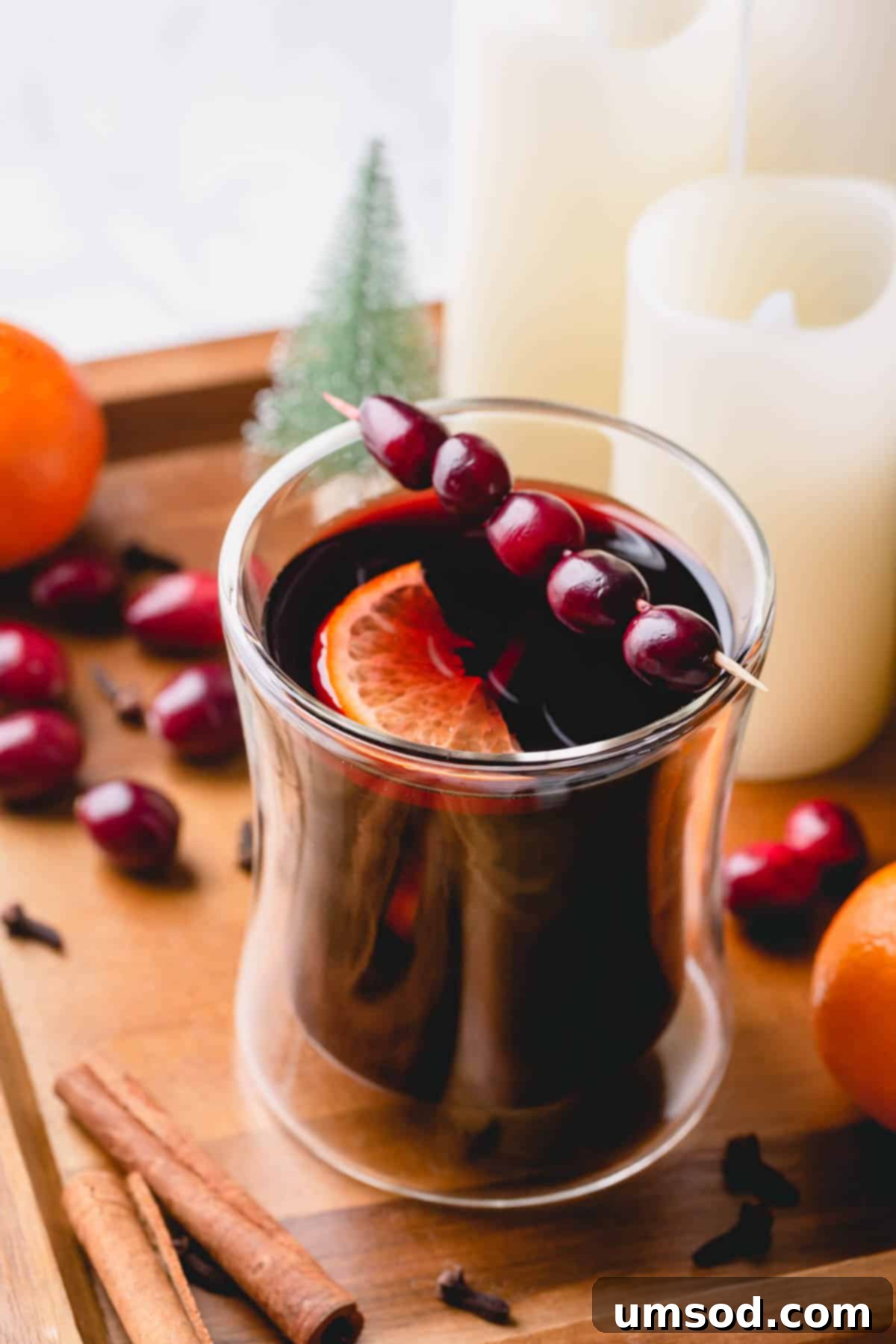Embrace the festive spirit with the ultimate homemade mulled wine recipe. Crafted with just 7 simple ingredients and designed for effortless preparation, this warm and aromatic spiced wine is guaranteed to make your holidays cozier and more memorable. Forget complicated concoctions; our guide provides make-ahead tips and customization ideas to help you create a truly exceptional winter beverage.
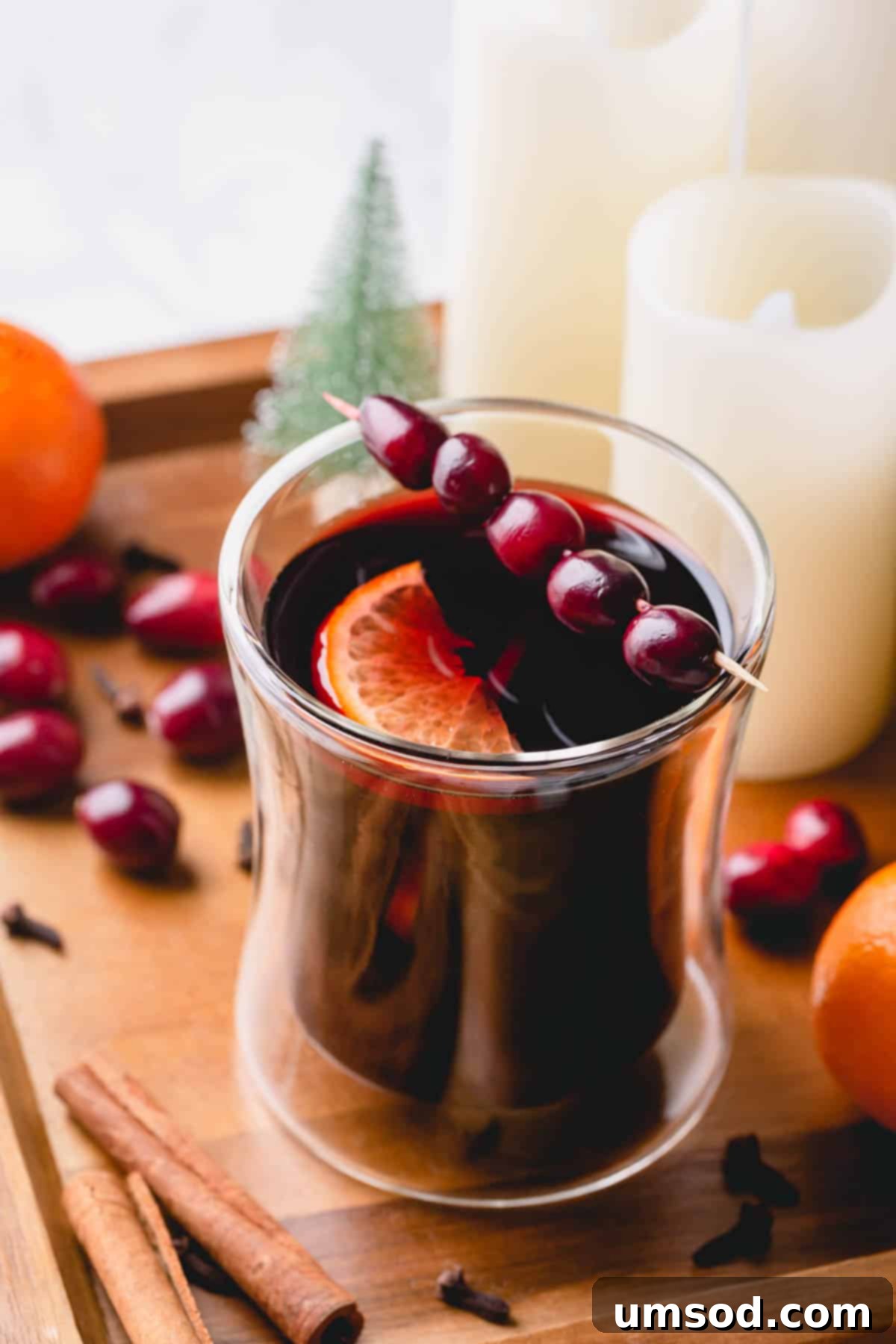
What is Mulled Wine? A Timeless Winter Tradition
Mulled wine, affectionately known as Glühwein in Germany, vin chaud in France, or glögg in Scandinavia, is a cherished warm spiced wine that captures the essence of winter celebrations across Europe and beyond. This aromatic concoction is typically crafted by gently simmering red wine with a medley of aromatic spices and often sweetened with sugar and citrus.
Its origins trace back to ancient Roman times, where Romans heated wine with spices to preserve it and boost its flavor. Over centuries, this practice evolved, becoming a staple at medieval feasts and later a quintessential beverage of European Christmas markets. Imagine wandering through a twinkling market, the scent of cinnamon and cloves filling the air, a steaming cup of mulled wine warming your hands – that’s the magic of this timeless drink.
Why You’ll Adore This Easy Homemade Mulled Wine Recipe
Having explored various renditions of mulled wine – from convenient store-bought mixes and teabags to charming cups served at bustling Parisian markets – I can confidently say that the homemade version stands out. It’s not just simple; it’s profoundly delicious and offers unparalleled freshness. Here’s why this recipe will become your go-to:
- Effortlessly Simple: This recipe proves that sophistication doesn’t mean complication. You’ll be surprised how quickly you can whip up a batch of this delightful drink.
- Pantry Staples: No exotic ingredients needed! Chances are, you already have most of what you need right in your kitchen.
- No Star Anise? No Problem!: While star anise is a traditional mulled wine spice, this recipe focuses on classic, universally loved flavors like cinnamon and cloves, perfect if star anise isn’t to your taste.
- Tailor to Your Taste: This recipe serves as a perfect foundation, inviting you to customize it with your favorite spices, fruits, and sweeteners.
- Fresher & More Flavorful: Using whole, fresh spices ensures a vibrant aroma and a cleaner taste, far superior to pre-mixed packets that can often taste stale or artificial.
- Impress Your Guests: Serving homemade mulled wine adds a touch of elegance and warmth to any gathering, making you the ultimate host!
Key Ingredients for the Perfect Mulled Wine
The beauty of this mulled wine recipe lies in its simplicity and the harmonious blend of core ingredients. My basic starting point for a consistently delicious batch always includes:
- A Whole Orange: Essential for its bright, citrusy notes that perfectly complement the spices.
- Whole Cloves: Provides a warm, pungent, and slightly sweet aroma.
- Orange Juice: Enhances the fruity base and adds a touch of natural sweetness.
- Granulated Sugar: Balances the tartness of the wine and other fruits, ensuring a smooth, delightful sweetness.
- Cinnamon Sticks: A cornerstone of mulled wine, offering a sweet and woody warmth.
- Cranberries (Fresh or Frozen, Optional): Adds a beautiful tartness and festive color.
- Dry Red Wine: The foundation of our drink. (More on selecting the best wine below!)
While these are the essentials, feel free to experiment. Sometimes, I’ll grate a little fresh nutmeg for an extra layer of warmth, or add a few cardamom pods. The beauty of homemade mulled wine is its adaptability.
The Advantage of Whole Spices in Mulled Wine
When crafting mulled wine, the choice between whole and ground spices makes a significant difference. It is highly recommended to use whole spices, such as whole cloves, cinnamon sticks, whole star anise, or even whole allspice berries.
The primary reason for this recommendation is textural integrity. Ground spices, when added directly to wine, can create an undesirable powdery or gritty texture, detracting from the smooth, inviting sip you desire. Whole spices, on the other hand, infuse their complex flavors gradually and elegantly without compromising the wine’s consistency.
Furthermore, whole spices are considerably easier to strain out once the mulled wine has achieved its desired flavor profile. This ensures a clear, appealing beverage that’s a pleasure to drink. They also tend to release their essential oils more slowly, preventing the drink from becoming overwhelmingly spiced too quickly.
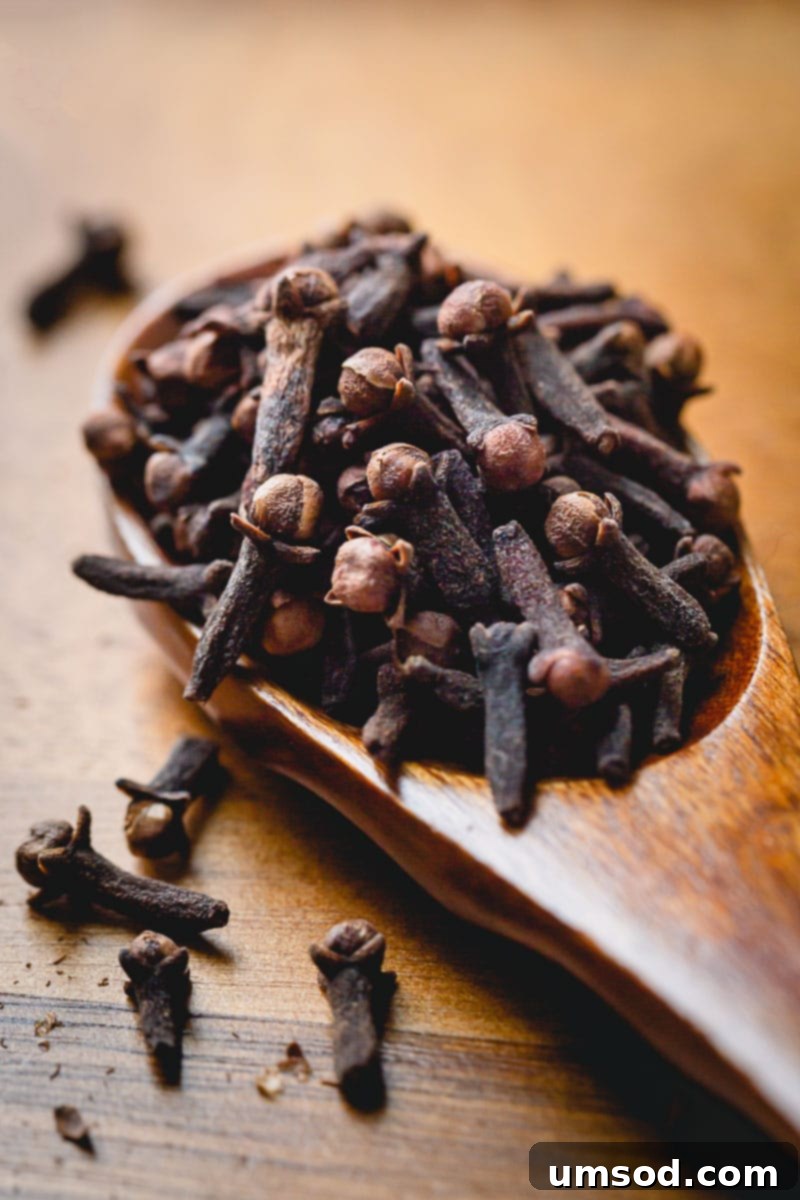
How to Craft Your Perfect Mulled Wine: Step-by-Step Guide
Making this incredibly flavorful mulled wine is surprisingly straightforward. Follow these simple steps for a cozy, spiced beverage:
- Prepare the Orange: Start by washing one whole orange thoroughly. Using a paring knife or a sturdy toothpick, gently push 8-10 whole cloves into the skin of the orange. This method is brilliant because it infuses the orange and wine with clove aroma without having tiny cloves floating around. Once studded, cut the orange into quarters.
- Create the Flavor Base: In a large, non-reactive pot or saucepan, combine the orange juice, granulated sugar, cinnamon sticks, the quartered oranges with cloves, and the optional cranberries (if using).
- Simmer to Syrup: Place the pot over medium-high heat. Stir the mixture occasionally to help the sugar dissolve completely. Once the sugar is dissolved, bring the mixture to a gentle boil. Continue to cook, reducing the heat slightly if boiling too vigorously, until the mixture thickens slightly and reduces by almost half, which usually takes about 15-20 minutes. This step is crucial as it concentrates the flavors of the spices and citrus into a rich syrup.
- Add the Wine: Reduce the heat to low. Carefully pour in one bottle (750ml) of dry red wine.
- Gently Heat Through: Allow the wine to simmer gently over low heat until it is heated through, typically about 10-15 minutes.
Expert Tip: Maintain the Alcohol!
Once you’ve added the wine, it’s crucial to avoid boiling the mixture. Boiling mulled wine will cause the alcohol to evaporate, significantly diminishing the festive kick. While it won’t ruin the flavor entirely, the essence of mulled wine often includes its warming alcoholic component. Keep it at a gentle simmer, just below boiling point, to retain the alcohol content and create a truly warming drink.
- Serve Warm: Once heated, you can either strain the wine to remove the spices and orange pieces for a smoother drink or leave them in for a more rustic presentation. Pour into heatproof mugs or glasses. Garnish with fresh orange slices, a cinnamon stick, or a few extra cranberries. Serve immediately and enjoy!
The simple trick of studding oranges with whole cloves is a game-changer! It beautifully infuses your mulled wine with that quintessential warm clove aroma and flavor.
Beyond the delightful fragrance, this method also spares you the tedious task of fishing out tiny, loose cloves from your finished drink. Enjoy the perfect balance of spice without any fuss!

Choosing the Best Wine for Mulled Wine
The secret to great mulled wine starts with selecting the right red wine. The good news is, you don’t need to break the bank! Any dry, full-bodied red wine works absolutely perfectly. Avoid anything too sweet, as you’ll be adding sugar and fruit, which could make the final drink overly saccharine.
Excellent choices for mulled wine include:
- Merlot: Smooth, with notes of plum and cherry, it’s a crowd-pleaser.
- Cabernet Sauvignon: Offers a bolder structure with hints of blackcurrant and a slight peppery finish.
- Zinfandel: Known for its jammy, fruity character, which lends itself beautifully to spiced flavors.
- Syrah/Shiraz: Provides dark fruit flavors and often a hint of spice already.
- Pinot Noir: Lighter-bodied but still flavorful, it’s a good choice if you prefer a less intense wine base.
The key is to pick something you genuinely enjoy sipping on its own – not necessarily your most expensive bottle, but a wine you wouldn’t mind drinking. A mid-range, palatable red is ideal, as the spices and sweetness will transform its character into something entirely new and wonderful.
Delightful Pairings: What to Serve with Mulled Wine
Mulled wine is a versatile festive drink that pairs wonderfully with a variety of holiday appetizers and hearty main courses. Its warm, spiced notes complement both sweet and savory dishes, enhancing the overall festive experience. If you’re planning a menu to serve alongside your spiced wine, consider these delicious options:
- Baked Brie: A warm, gooey baked brie, especially with a fruit compote or honey, makes a perfect decadent appetizer to serve with a cup of warm mulled wine.
- Prime Rib: As a classic holiday centerpiece, the rich, savory flavors of prime rib pair exquisitely with the robust notes of red wine-based mulled wine.
- Pork Schnitzel: For an authentic European touch, pork schnitzel is a traditional and delightful pairing for Glühwein in Germany and Austria. The crispy fried pork complements the sweet and spicy drink.
- Bacon Wrapped Filet Mignon: The tender, rich filet mignon wrapped in savory bacon is another excellent choice that stands up beautifully to the flavors of mulled wine.
- Gingerbread Cookies or Cake: For a sweet ending or a lighter pairing, the warm spices in gingerbread resonate perfectly with mulled wine.
- Cheese Platter: A selection of aged cheeses, particularly cheddar or Gouda, along with nuts and dried fruits, creates a delightful contrast.
Make-Ahead & Storage Tips for Stress-Free Entertaining
Mulled wine is truly the perfect holiday party drink because it can be largely prepared in advance, allowing you to enjoy your guests without last-minute fuss. You can easily double or even triple this recipe to serve a larger crowd.
- Prepare the Spice Syrup in Advance: Follow steps 1-4 of the recipe (combining oranges, spices, juices, and sugar, and simmering to a syrup). Let the syrup cool completely, then transfer it to an airtight container and store it in the refrigerator for up to 3 days. When you’re ready to serve, simply combine the prepared syrup with the red wine in a large pot and gently warm it through over low heat.
- Keep it Warm in a Slow Cooker: For extended serving, especially at parties, a slow cooker is your best friend! Once your mulled wine is fully prepared and heated through, transfer it to a slow cooker set on the “warm” setting. This keeps the mulled wine at the perfect temperature without boiling, ensuring it stays cozy and inviting for hours.
- Storing Leftovers: Leftover mulled wine can be stored in an airtight container in the refrigerator for up to 2-3 days. Reheat gently on the stovetop over low heat, being careful not to boil.
These make-ahead strategies ensure you can enjoy the festivities as much as your guests, with a delicious, aromatic mulled wine always at hand.

Frequently Asked Questions About Mulled Wine
Any dry, full-bodied red wine works perfectly! We recommend varietals like Merlot, Cabernet Sauvignon, Zinfandel, Syrah, or Pinot Noir. The key is to choose a wine you’d enjoy drinking on its own, but it doesn’t need to be expensive.
Classic spices for mulled wine include cinnamon sticks, whole cloves, and star anise. This recipe focuses on cinnamon and cloves. For variations, you can also add freshly grated nutmeg, cardamom pods, a few slices of fresh ginger, or even a bay leaf for an unexpected herbal note.
Absolutely! You can easily make a delicious non-alcoholic version by substituting the red wine with cranberry juice, grape juice, or even a strong hibiscus tea. Follow the same steps, simmering with the spices and citrus, for a family-friendly winter warmer.
Homemade mulled wine can be stored in an airtight container in the refrigerator for up to 2-3 days. It’s best consumed fresh, but reheating gently on the stovetop (avoiding a boil) will still yield a delightful drink.
While fresh oranges provide the best flavor, you can use high-quality orange juice (not from concentrate, if possible) and add some dried orange peel or zest during the simmering process for a similar aromatic effect. You might also add a splash of lemon juice to brighten the flavors.
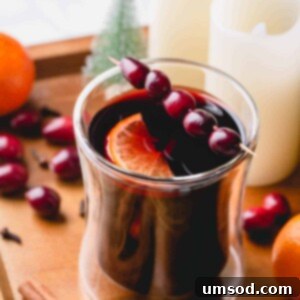
Homemade Mulled Wine
Comment
Print Recipe
Ingredients
- 1 orange
- 8-10 whole cloves
- 1 cup (240ml) orange juice
- ½ cup (100g) granulated sugar
- ½ cup cranberries fresh or frozen, optional
- 1-2 cinnamon sticks
- 1 bottle (750ml) dry red wine (See Note 1 for wine recommendations)
Instructions
- Prepare Orange: Cut an orange into quarters. Push 2-3 whole cloves into the outer skin of each orange quarter, as pictured in the post above. This method ensures great flavor without loose cloves.
- Combine Spices & Fruit: In a large pot or saucepan, combine the orange juice, sugar, cinnamon sticks, the quartered oranges with cloves, and cranberries (if using).
- Dissolve Sugar: Turn the heat to medium-high and slowly heat the mixture, stirring occasionally until the sugar is completely dissolved.
- Simmer Syrup: Once the sugar is dissolved, bring the mixture to a boil. Reduce heat slightly and cook until it has thickened and reduced by almost half, typically about 15-20 minutes. This concentrates the flavors.
- Add Wine: Reduce the heat to low and carefully pour in the bottle of dry red wine.
- Heat Gently: Simmer the wine gently over low heat until it is heated through. Important: Do not boil the wine, as this will cause the alcohol to evaporate.
- Serve: You can strain the wine to remove the spices and fruit, or leave them in for presentation. For entertaining, pour into a slow cooker set to ‘warm’ to keep it hot longer. Garnish with fresh orange slices or extra cranberries and serve warm.
⭐️ Did you make this recipe?
Please leave a review and let us know how you liked it!
Tips & Notes
Make-Ahead Tip: Follow instructions steps 1-4 to make the spiced orange syrup. Cool completely and store in the fridge for up to 3 days. When ready to serve, mix with wine in a large pot and warm it up. For parties, transfer to a slow cooker to keep it warm longer.
Nutrition
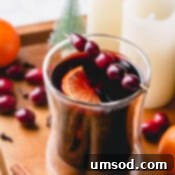
Leave a rating and your feedback. Thank you!
This post was originally published on November 28th, 2014, and has been updated for clarity, comprehensiveness, and enhanced user experience.
